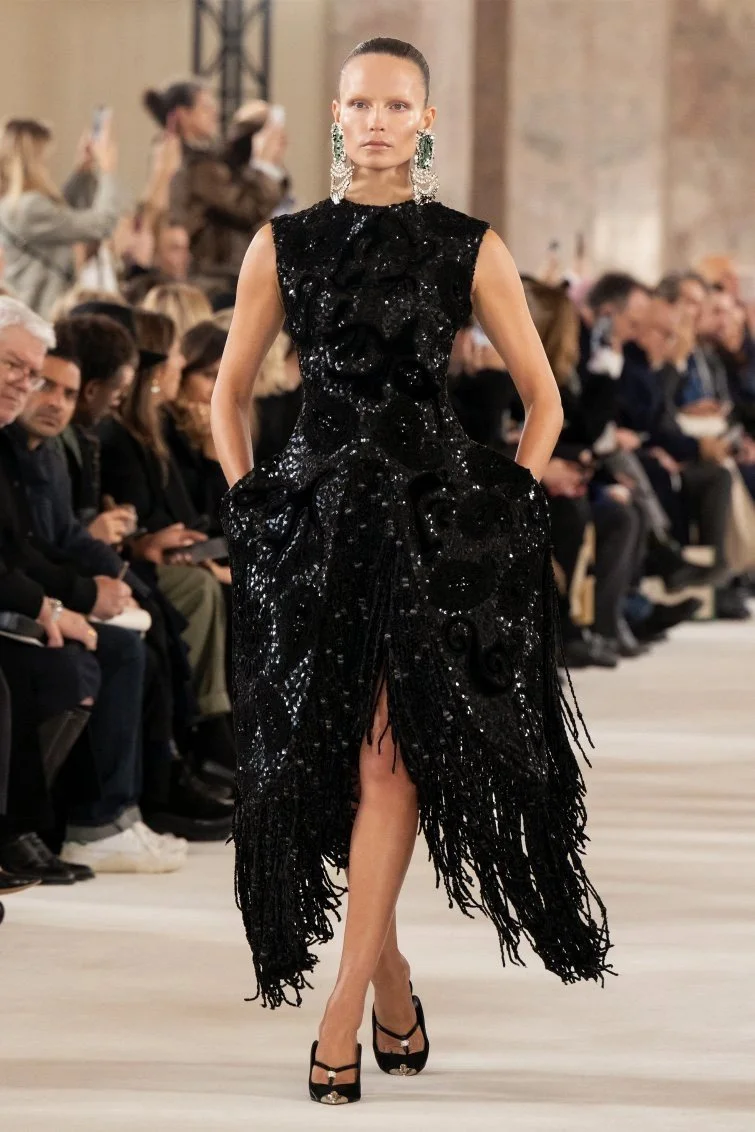A COMPILATION OF FASHION WEEK TRENDS
BY AIDEN COX PHOTOS BY PROVIDED
Paris: The robe de style of Jeanne Lanvin
Paris-based designer Jeanne Lanvin’s signature dress style circa 1920s is making a comeback. The silhouette is a dropped waist and a full skirt, both professional and feminine. There has been an influx of flowery, flowy, flattering fashion this season in Prada, Dries Van Noten, and Chanel’s chintzy prints. Cheaper dresses reminiscent of these pieces are available here and here
New York: A Rick Owens color palette
Blacks, grays, whites, and metallics dominate other runways this season. In the age of fast fashion, materiality and archetypal fashion have become increasingly important to designers. Houses like Schiaparelli, Margiela, and Dior are pulling pieces and references from the archives to capture these timeless looks. Leather, thick denim, cow print, and layered fabrics are back in style. See some iconic archival pieces referenced here and here.
Prada’s baby is all grown up. Miuccia Prada said it best in “Schiaparelli and Prada: Impossible Conversations,” “Miu Miu, which I launched in 1993, was never intended to be a secondary line. But whereas Prada was serious and grown up, Miu Miu — my childhood nickname — was girlish and playful. It was intuitive and instinctive. And over the years Miu Miu has matured. Now I don’t see any difference between the two labels. Ideas or concepts that I originate for Prada appear in Miu Miu and vice versa. There’s a lot of synergy between the two.”
Brands like Loewe, Chloé, and The Rowe have capitalized on clean girl aesthetics and younger audiences. Their models often wear mismatched statement pieces, styled simply, as though they were rushing out the door and woke up with perfectly done hair and glass skin. This effortless chic is a consistent ideal for many influencers and content creators.
London: Contemporary Sculpture
High fashion is leaning into other artistic endeavors this season, though one wonders if these artworks are conceptualized by the designers or their marketing departments. Contemporary art in London officially began in 1910 through the Contemporary Art Society, run by Roger Fry, and gained popularity over the next 50 years.
This year, numerous pieces seemed to be a statement on overconsumption and excess in our current wasteful world. Tadashi Kawamata installed a huge pile of vintage chairs called “AVALANCHE” in Paris. The Issey Miyake, Diesel, and Vetements show all utilized piles of “junk” on the runways, from washi tape to denim scraps to donated garments.
It’s good that designers are acknowledging the often destructive practices of fashion, but there is a sinister undertone to these works. After all, the excessive waste displayed is what comes out of these fashion houses, and their marketing departments are still looking to capitalize off of privileged people while utilizing unsustainable practices to create cheaper clothes. One wonders if the ethos these designers seem to follow is actually possible under capitalism.
Other Notable Pop Culture Moments
Anok Yai as a runaway bride was hard to miss. Yai once again cements herself as one of the top models of this new generation. Having trouble with the length and folds of her dress, she decided to turn and run back down the runway, bringing back the storytelling and emotion of models in the 90’s. Watch her runaway performance here.
Willem Dafoe closed Miu Miu when he stepped out in a navy trench coat and understated menswear at the end of the show in Paris.
Many clothes this season consisted of strange materials, including a DHL tape mini dress, a press-on-nails red mini dress, a mother-of-pearl trench, and a dress made of mirrors.
Makeup artist Pat McGrath’s glass makeup stunned on the runway. McGrath started the glass skin trend after sending the Margiela models out on the runway looking like porcelain dolls.
